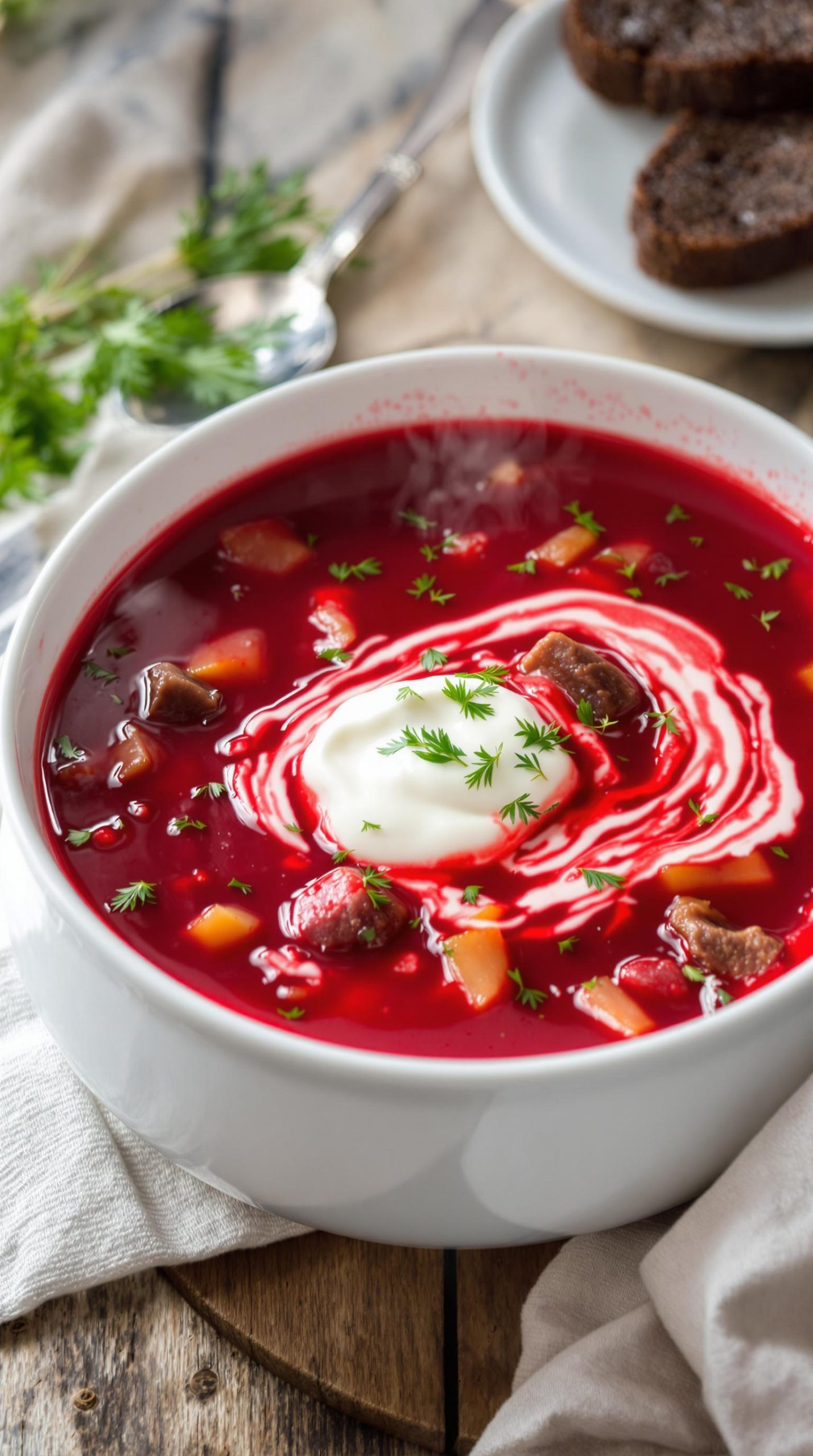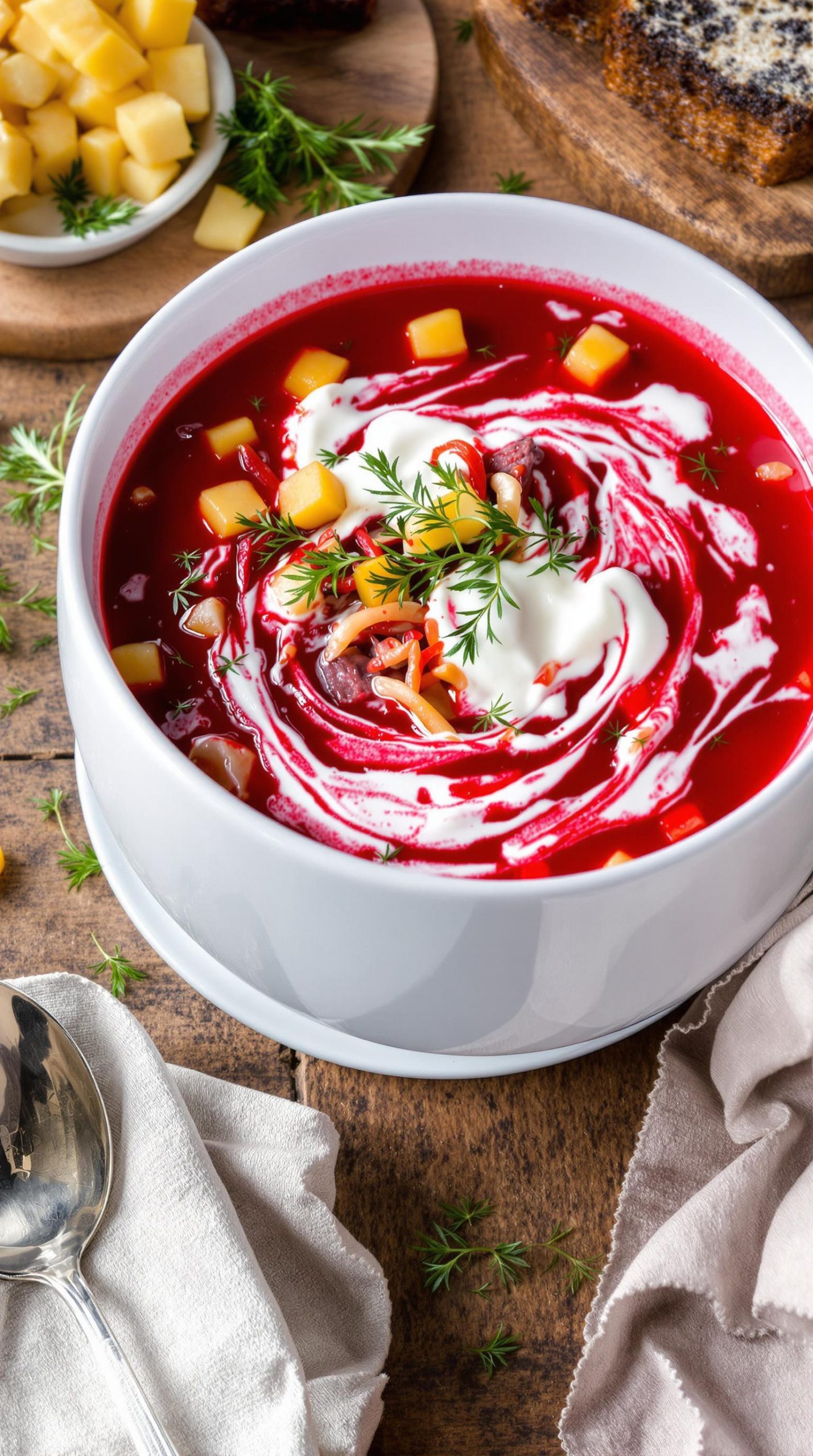Why You’ll Love this Traditional Borscht
Three reasons you’ll love this traditional borscht recipe.
First, it’s packed with incredible depth of flavor—tender beef, earthy beets, and that signature tanginess that warms you to your core. Nothing beats a bowl when the weather turns chilly.
Second, it’s surprisingly versatile. Don’t have all the ingredients? No problem. The soup adapts beautifully to what you have on hand.
Third, it’s even better the next day, making it perfect for meal prep. The flavors meld together overnight, creating a soup that’s practically a different dish by morning.
What Ingredients are in Traditional Borscht?
Traditional borscht is a hearty, soul-warming soup that’s been perfected over generations. The beautiful deep red color comes from beets, but don’t be fooled—this isn’t just a beet soup. It’s a symphony of flavors with meat, vegetables, and a perfect balance of tanginess that makes it distinctively borscht.
While there are countless variations across Eastern Europe, this traditional recipe includes all the classic components that create that unmistakable flavor profile we recognize and love.
- 1½ pounds beef shank or flank steak
- 1 meaty ham bone (about 1 pound)
- 2 beef bones with marrow (about 1 pound)
- 3 quarts water
- 1 onion
- 1 carrot, peeled
- 2 medium parsnips, peeled
- 1 stalk celery with leaves
- 3 dill sprigs
- 3 parsley sprigs
- 4 bay leaves
- 10 black peppercorns
- Salt, to taste
- 2 large beets (about 1¼ pounds)
- 4 medium boiling potatoes, peeled and cut into large pieces
- 1 pound fresh ripe plum tomatoes, peeled and chopped (or 16-ounce can)
- Lemon juice
- Sour cream (for serving)
What makes borscht special is how flexible the ingredient list can be while still maintaining its essential character.
Don’t have parsnips? The soup will survive. Vegetarians can skip the meat entirely and use vegetable broth instead. Some regional variations might add cabbage, beans, or even apples for sweetness. The non-negotiables are really just the beets (for that signature color and earthy sweetness) and that tangy finish from lemon juice or vinegar.
And whatever you do, don’t skip the dollop of sour cream when serving—it’s not just a garnish but an essential component that brings everything together.
How to Make this Traditional Borscht

Begin by creating a rich, flavorful stock. In a large soup pot, combine 1½ pounds of beef shank or flank steak with a 1-pound meaty ham bone and 2 beef bones with marrow in 3 quarts of water. Bring this mixture to a boil over high heat, skimming off any foam that rises to the surface. This step is essential for a clear, beautiful broth.
Once it’s boiling, add one onion, one peeled carrot, 2 medium peeled parsnips, a stalk of celery with leaves, 3 sprigs each of dill and parsley, 4 bay leaves, 10 black peppercorns, and salt to taste. Reduce the heat to low and let it simmer partially covered until the meat becomes tender—at least 45 minutes, though I find the flavors develop even more beautifully if you can let it go for closer to an hour. Using a premium soup pot with excellent heat distribution will ensure even cooking and help develop those deep, complex flavors.
While your stock simmers away, preheat your oven to 375°F and prepare the beets—the star of the show. Wash and dry 2 large beets (about 1¼ pounds), wrap each one separately in aluminum foil, and bake until they’re tender, about 1¼ hours. Once they’re cool enough to handle, peel them and cut into julienne strips or a fine dice.
Next, strain your completed stock through a fine sieve into a clean pot, setting aside the meat but discarding the vegetables and herbs. Bring the strained stock back to a boil, add 4 medium potatoes cut into large pieces and 1 pound of peeled, chopped tomatoes. Let this simmer for about 10 minutes until the potatoes are almost tender.
Finally, toss your prepared beets with ¼ cup lemon juice before adding them to the soup. Cut the beef into bite-sized pieces, return it to the pot, and let everything simmer together for another 5-7 minutes. The soup needs to rest for at least 15 minutes before serving, which allows all those gorgeous flavors to meld together.
And remember, borscht isn’t truly complete without that traditional dollop of sour cream on top—it’s what transforms this from delicious to transcendent. For an authentic outdoor cooking experience, you could prepare this recipe using a smoker grill that adds a subtle smoky dimension to the rich broth.
Traditional Borscht Substitutions and Variations
While every family’s borscht recipe has its own unique twist, there’s plenty of room to adapt this classic dish to your pantry and preferences.
You can swap beef for pork, lamb, or skip meat entirely for a vegetarian version. No beets on hand? I’d be hesitant to call it borscht, but in a pinch, you can use pickled beets.
Some regions add beans, others include apples for sweetness. The vegetables are flexible too—try turnips instead of parsnips, or add mushrooms for earthiness.
Can’t find fresh dill? Dried works in a pinch, though you’ll miss that aromatic finish that makes borscht so comforting.
What to Serve with Traditional Borscht
A steaming bowl of borscht isn’t complete without the perfect accompaniments to round out your meal. I always serve mine with a dollop of sour cream—it adds that creamy tang that balances the earthy beets perfectly.
Warm, crusty bread is non-negotiable, preferably a dark rye or sourdough to sop up every last drop of that ruby broth.
For a more substantial spread, add a plate of pickled vegetables—cucumber, cabbage, or mushrooms work wonderfully.
And if you’re feeling fancy, why not include some pirozhki (small stuffed buns) on the side? Trust me, your taste buds will thank you.
Final Thoughts
After making this borscht recipe countless times, I’m convinced it’s one of those dishes that gets better with each attempt. The rich, earthy flavor of the beets alongside tender beef creates a symphony of taste that’s truly unmatched in the soup world.
Don’t you love how the vibrant red color brightens even the dreariest winter day? It’s comfort in a bowl, really. The beauty of borscht lies in its flexibility—add more garlic if you’re feeling bold, or extra lemon juice for tanginess. Similar to turkey soup, you can repurpose leftover meat to create a nutritious and flavorful meal with minimal waste. Just like with warm spices in fall baking, the seasonings in borscht can be adjusted to suit your personal taste preferences.





